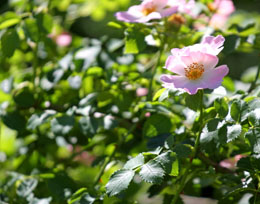Flowering plant reproduction takes place by means of both asexual and sexual methods. The asexual method in flowering plants is simple, while the sexual method is highly complex and organized.

As the name goes, flowering plants produce flowers for the purpose of reproduction. Collectively, they are also known as angiosperms, and classified under the division
Angiospermae. According to botanists, they represent the most diverse group, with about 250,000-400,000 species, and contribute to 90 percent of the species in the plant kingdom. The angiosperms along with the gymnosperms are the only seed producing types.
Before we start with reproduction of flowering plants, let's try to understand the anatomy of a flower. There are four different parts, viz., sepal (calyx), petal (corolla), androecium (male part), and gynoecium (female part). In short, it serves as a reproductive organ having the male gamete and female gamete, along with accessory whorl (sepal and petal). Nevertheless, there are also some species, in which the male part and female part are borne in separate ones.
Asexual Reproduction
Asexual reproduction refers to the production of new, genetically similar individuals from a single parent without fertilization. In case of flowering plants, new plants are propagated from the vegetative parts, such as leaves, stems, roots, rhizomes, bulbs, tubers, runners, etc. When maintained in a favorable growing environment, the vegetative part regenerates into a different plant. In botanical terms, such a process is called vegetative propagation.
Sexual Reproduction
By sexual method, we mean the mode of flowering plant reproduction that involves fusion of male and female gametes, through fertilization process. Before the flower opens, the petals protect the reproductive structures, androecium, and gynoecium. The androecium contains many stamens, each of which has an anther located at the top of a filament. Also, the gynoecium contains several carpels, wherein an individual carpel is made up of stigma, style, and ovary.
At maturity, the anther splits and releases pollen grains in large amounts, which are the male gametophytes (each having 2 cells - the germ cell and tube cell). On the other hand, the female gametophyte or embryo sac (having 7 cells and 8 nuclei) is developed in the ovary. After the formation of pollen grains and embryo sac, the pollens are transferred to the stigma. This transfer of pollens is called pollination, and marks the beginning of fertilization.
On reaching the receptive stigma, the pollen grain undergoes germination to form pollen tube. This tube passes through the style to reach the embryo sac, where the egg cell is present. In the meantime, the germ cell inside the pollen divides to form two sperm cells, which then travel down to the embryo sac, via the pollen tube. From the two sperm cells, one fertilizes the egg, resulting into a zygote. The remaining sperm cell fuses with the two polar nuclei present at the near center of the embryo sac, forming endosperm.
Since fusion of male gametes with egg cells occur twice in flowering plants (for formation of zygote and endosperm), the whole process is referred to as double fertilization. The endosperm later develops as the nutritive part of the fruit that stores nutrients for the zygote. This zygote represents the sporophyte of the next generation. In a nutshell, the life cycle of a flowering plant has two generations - a long sporophyte phase (diploid), along with a short gametophyte phase (haploid), and sexual reproduction is the basis for creating varieties in the future generations of the plant.
After fertilization is over, the end result of reproduction is formation of the seed. The seed then germinates into a plant, which produces flowers at maturity. Following this, the whole process is repeated again.






 As the name goes, flowering plants produce flowers for the purpose of reproduction. Collectively, they are also known as angiosperms, and classified under the division Angiospermae. According to botanists, they represent the most diverse group, with about 250,000-400,000 species, and contribute to 90 percent of the species in the plant kingdom. The angiosperms along with the gymnosperms are the only seed producing types.
As the name goes, flowering plants produce flowers for the purpose of reproduction. Collectively, they are also known as angiosperms, and classified under the division Angiospermae. According to botanists, they represent the most diverse group, with about 250,000-400,000 species, and contribute to 90 percent of the species in the plant kingdom. The angiosperms along with the gymnosperms are the only seed producing types.